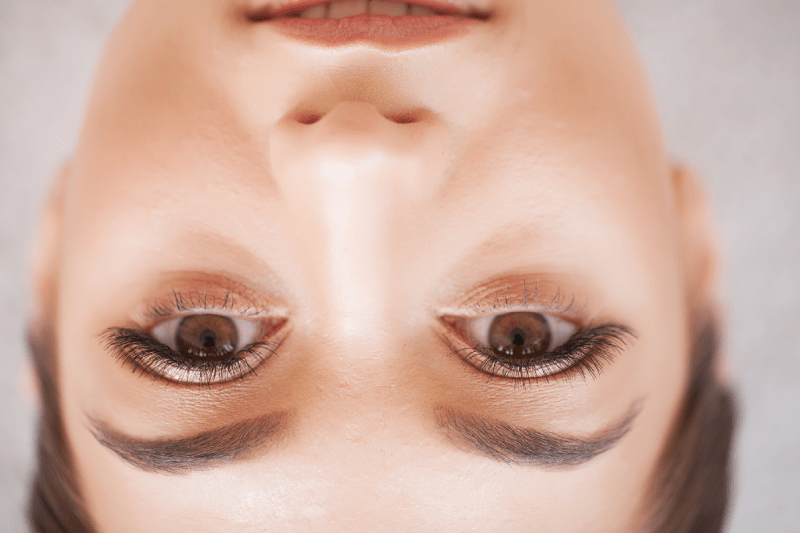What is Upper Eyelid Aesthetics (Blepharoplasty)?
Upper eyelid aesthetics, medically referred to as upper blepharoplasty, is the surgical procedure of removing excess skin, herniated fat pads, and in some cases, loose muscle tissue accumulated on the eyelid. This operation not only addresses aesthetic concerns but also aims to resolve functional issues such as restricted vision field caused by the sagging skin. Blepharoplasty, which grants the eye area a younger, more vibrant, rested, and energetic expression, is planned to leave minimal scarring and is generally a very safe procedure performed under local anesthesia. The surgery contributes significantly to the overall facial rejuvenation by lifting the heaviness from the patient’s gaze.
Why Do Eyelids Sag and Look Old?
The primary causes of eyelid sagging (ptosis) are factors inevitably encountered during the skin’s aging process. As age advances, the production of collagen and elastin, the essential building blocks of the skin around the eyes, decreases. This loss of elasticity, combined with the effect of gravity, leads to the skin drooping downwards. Other common causes include genetic predisposition (some individuals start sagging at an earlier age), sun damage (excessive exposure to UV rays), weakening of the periocular muscles (orbicularis), and the relaxation of the muscles that lift the eyelid (levator). The herniation of fat pads also contributes to a puffy and tired appearance of the eyelids.
Who is Suitable for Upper Eyelid Surgery?
Ideal candidates for upper eyelid surgery are generally individuals aged 35 and older who have a noticeable amount of excess skin on their eyelids, a constantly tired expression, and a feeling of difficulty waking up in the mornings. The most common complaints from candidates are makeup creasing into the eyelid fold, restriction of the field of vision due to sagging skin at the edges, and the constant need to lift the eyebrows. All healthy individuals with functional complaints (vision restriction) and realistic aesthetic expectations, who do not suffer from serious eye diseases (uncontrolled glaucoma, severe dry eye), are suitable for this surgery. It is expected that candidates do not smoke or quit before the surgery, as this enhances healing success.
What Preparations Should Be Done Before Surgery?
Before blepharoplasty surgery, a meticulous preparation process is required to guarantee surgical success and minimize risks. This process includes: Detailed Eye Examination: An examination by an ophthalmologist (eye doctor) is necessary to ensure conditions like dry eye or glaucoma do not interfere with the surgery. Medication Adjustment: Blood-thinning medications (aspirin, ibuprofen, etc.), herbal supplements, and Vitamin E should be discontinued at least 10 days before the operation. Smoking Cessation: Since smoking severely delays wound healing, it must be stopped at least two weeks before the surgery. Medical Clearance: Patients with chronic conditions must receive general surgical clearance. The surgeon finalizes the surgical plan with photos and 3D analyses.
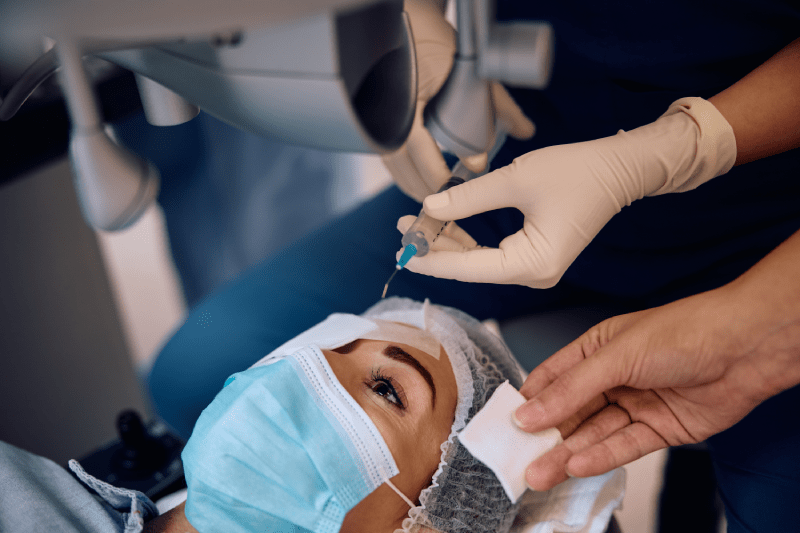
How is Upper Blepharoplasty Surgery Performed? (Surgical Technique)
Upper blepharoplasty surgery is one of the most delicate procedures in aesthetic surgery. The surgeon marks the boundaries of the excess skin to be removed, while the patient is in an upright position, along the natural crease line (folding line) of the eyelid. During the surgery, a fine incision is made along this marked area. The excess skin, the minimal underlying muscle tissue, and herniated fat pockets are meticulously removed. The incision line is closed with very fine aesthetic sutures (typically 6/0 or 7/0) or special tissue adhesives. Since this incision line is hidden within the natural fold, the scars become almost invisible after healing. The success of the surgery depends on removing neither too much nor too little tissue; this demands the surgeon’s experience.
What is the Duration of the Surgery and What Type of Anesthesia is Used?
Upper eyelid aesthetics is generally a very fast procedure. Upper blepharoplasty alone takes, on average, between 45 minutes and 1 hour for both eyelids. The duration may increase if combined with additional procedures like lower eyelid surgery or a brow lift. The surgery is predominantly performed under local anesthesia and sedation, where the patient is awake but feels no pain and is relaxed with tranquilizing medications. This anesthesia method ensures patient comfort and eliminates the risks of general anesthesia, shortening the discharge time. Patients can return to their homes or hotels shortly after the surgery.
What are the Aesthetic and Functional Benefits of the Surgery?
The benefits provided by upper blepharoplasty surgery directly improve the patient’s quality of life: Aesthetic Improvement: The aged, tired, and sad expression around the eyes is replaced by a more dynamic, vibrant, and youthful gaze. The eyes appear more open and defined. Easier Makeup Application: Since the sagging skin is removed, applying eye makeup (eyeshadow, eyeliner) becomes easier, and makeup creasing is prevented. Functional Improvement: Especially in cases of advanced sagging (pseudoptosis), the restriction of the visual field caused by the upper lid is eliminated. The patient’s effort to constantly raise their eyebrows to see is reduced, alleviating frontal and headaches.
Post-Surgery Pain and Swelling Management
Post-blepharoplasty pain complaints are usually lower than expected. Pain is easily controlled with simple oral analgesics. The most common conditions encountered are swelling (edema) and bruising (ecchymosis). These symptoms are due to surgical trauma and peak within the first 48 hours. To manage swelling and bruising: Cold Compress: Intermittent application of ice compress during the first 48 hours post-surgery. Head Elevation: Keeping the head elevated while sleeping or resting helps the edema drain quickly. Bruising and swelling generally decrease significantly within 7 to 10 days, facilitating the return to social life.
Recovery Period and When to Return to Daily Life?
The recovery period after upper blepharoplasty is quite rapid. Patients are usually discharged on the day of the surgery. Light daily activities (reading, using a computer, watching television) can be resumed within 2-3 days. Stitches are removed 5 to 7 days after the operation. The time for significant reduction of swelling and bruising and full return to social life is approximately 10 days. However, the incision line’s full softening and final appearance may take between 6 months and 1 year, varying from person to person. Compliance with the surgeon’s instructions during the recovery period accelerates the process.
Does Upper Eyelid Surgery Leave Scars?
One of the most important advantages of this surgery is that aesthetic results are achieved with minimal scarring. Since the surgical incision is placed in the natural crease line of the eyelid, the scars are perfectly hidden by this fold. The thin structure of the eyelid skin helps the scars fade and disappear quickly. After the stitches are removed, the scar line may be slightly pink, but this gradually fades to match the skin tone. The surgeon’s meticulous suturing technique and the patient’s wound healing potential minimize the visibility of the scars.
When Are the Stitches Removed and How Should Wound Care Be Done?
The sutures used in upper blepharoplasty are usually non-absorbable, very fine threads (sutures), and these are removed 5 to 7 days after the surgery. The stitch removal process is very quick and painless. Wound care is critical: The wound must be kept dry for the first 48 hours. The antibiotic ointments recommended by the surgeon should be regularly applied to the wound line. After the stitches are removed, sun protection and, if necessary, silicone-based scar creams should be used to support scar healing. Keeping the wound clean is the most important step in preventing the risk of infection.
When Can Makeup Be Applied After Surgery?
To prevent the risk of infection and avoid external factors that could negatively affect the wound healing process, the use of makeup should be avoided after the surgery. Makeup application on the eyelid (especially eyeshadow and eyeliner) can generally begin after the stitches have been completely removed and the incision line has fully closed, which is typically around 10 to 14 days after the operation. Initially, hypoallergenic and mineral-based makeup products that will not irritate the eyes should be preferred. Makeup will be easier to apply, highlighting the aesthetic crease of the healed eyelid.
Are the Results of Upper Eyelid Surgery Permanent?
The results of upper eyelid surgery are very long-lasting and permanent. The excess skin and herniated fat tissue permanently removed during the surgery do not regenerate. However, since the overall aging process and the effect of gravity continue, a slight relaxation in the eyelids or eyebrows may occur again within 10 to 15 years after the surgery. This does not mean the surgery was unsuccessful, but rather that the natural aging process is continuing. To preserve the results of the surgery, using regular sun protection and maintaining a healthy lifestyle are important.
Eyebrow Lift (Brow Lift) and Eyelid Combination
In some patients, eyelid sagging results not only from excess skin but also from the descent of the eyebrows with age (brow ptosis). In this case, if only upper blepharoplasty is performed, the result may be insufficient, or the eyebrows may continue to descend undesirably. Therefore, Eyebrow Lift (Brow Lift) surgery can be combined with upper eyelid aesthetics. The brow lift brings the eyebrows to a more youthful and aesthetic position; this relieves the pressure on the eyelid, optimizing the blepharoplasty result.
The Difference of Upper Eyelid Aesthetics in Men
Upper eyelid aesthetics in men has different aesthetic goals than in women. The goal for men is to maintain a flatter and more masculine eyelid and eyebrow structure, preserving the face’s natural and masculine character. Excessive skin removal or a feminizing brow lift may lead to an unnatural, “surprised” look in men. The surgeon adopts a minimal invasive and measured approach to remove only the functional excess and preserve the natural position of the brow just above the bone ridge.
What Are the Non-Surgical Eyelid Aesthetics Alternatives? (Botox/Laser)
There are some non-surgical methods available for patients who are hesitant about surgery or have only mild sagging. Botox (Botulinum Toxin): By relaxing the muscles that pull down the tail of the eyebrows, it indirectly lifts the tip of the brow slightly, giving the eyelid a more open appearance. Laser/Radiofrequency Treatments: Stimulates collagen fibers under the skin to induce tightening and reduce mild levels of skin laxity. These methods cannot replace the surgical results in cases of advanced skin excess but can be used for mild early sagging or to maintain the surgical result. Non-surgical solutions are not recommended for cases with advanced skin excess.
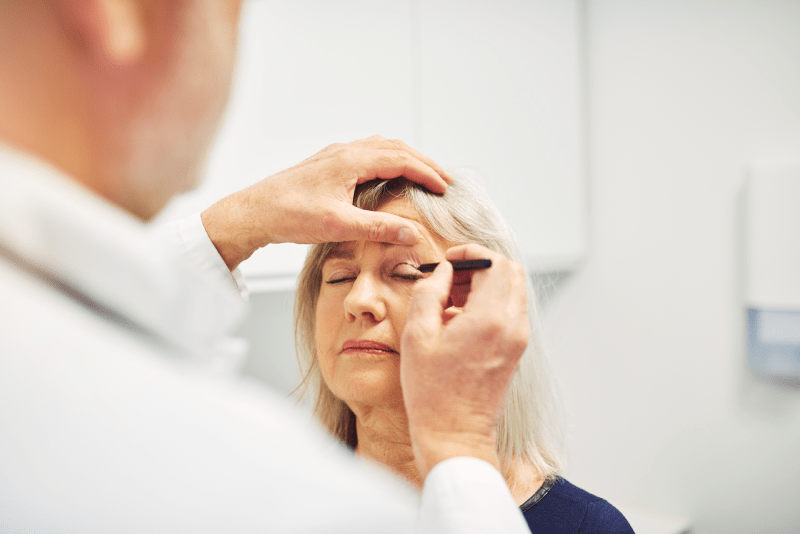
The Difference Between Eyelid Drooping (Ptosis) and Blepharoplasty
Eyelid drooping (Ptosis) and aesthetic sagging (Dermatochalasis) are different conditions. Ptosis is when the eyelid rests lower than normal, covering part of the pupil, due to the weakening or relaxation of the muscle that lifts the eyelid (Levator Muscle). Blepharoplasty (Aesthetic Sagging) is the laxity caused by excess skin and fat tissue, rather than a muscle problem. Ptosis treatment requires different surgical techniques, such as muscle shortening or repair. If a patient has both aesthetic sagging and ptosis, the surgeon must apply both blepharoplasty and ptosis surgery simultaneously.
Risks and Complications to Be Aware of After Surgery
Although upper blepharoplasty is a low-risk surgery, some complications may occur: Infection: Development of infection in the surgical area. Hematoma/Excessive Bruising: Rarely, large areas of bleeding. Asymmetry: Minimal but noticeable difference remaining between the two eyelids. Excessive Skin Removal: In very rare cases, the inability of the eyelid to close completely (lagophthalmos) or increased dry eye complaints. Ectropion: Eversion of the lower eyelid (very rare in the upper lid). The surgeon’s experience plays a key role in minimizing these risks.
Possibility and Reasons for Revision Surgery
The need for revision after successful upper blepharoplasty is low. However, revision may be required in some situations: Insufficient Correction: The surgeon removing too little skin, leading to persistent sagging. Overcorrection: Inability of the eyelid to close completely due to too much skin removal. Asymmetry: Persistent significant asymmetry after surgery. Revision surgery is usually performed after waiting at least 6 months to 1 year after the initial operation for the tissues to fully heal. Revisions are often more complex than the initial surgery.
The Effect of Upper Eyelid Surgery on Eye Health
When planned correctly, upper eyelid surgery does not harm eye health; on the contrary, it improves function, especially in individuals with restricted vision field. However, some temporary post-operative conditions may occur: Dry Eye: Sensation of dryness due to the eyelids not closing completely in the first few days because of swelling. Tearing: Temporary reaction of the tear drainage system. These conditions usually resolve spontaneously within a few weeks and are managed with appropriate eye drops. It is essential for patients with serious eye diseases to be cleared for surgery by an ophthalmologist beforehand.
Can Lower Eye Bags (Lower Lid) Be Operated Concurrently?
Yes, upper eyelid aesthetics is frequently combined with Lower Eyelid Aesthetics (Lower Blepharoplasty) in patients who also have complaints of under-eye bags, puffiness, or dark circles. Lower lid surgery aims to reposition or remove the excess fat pads causing the bags. Performing both surgeries simultaneously allows for holistic and harmonious rejuvenation around the entire eye area with a single anesthesia and a single recovery period. Combined procedures increase the surgical time but maximize the patient’s general comfort in the long term.
What is Laser-Assisted Blepharoplasty?
Laser-assisted blepharoplasty is not a technique where a laser (usually CO2 Laser) is used instead of a surgical incision. The laser is typically used as an ancillary tool to minimize bleeding during the incision or to support skin rejuvenation. Additionally, fractional laser application can be done on the skin surface after the incision to utilize the skin tightening effect. However, fundamentally, a surgical incision is still necessary to remove the excess skin. Laser use can potentially reduce post-operative bruising and swelling and may increase the healing rate.
The Importance of Skin Quality in Periorbital Rejuvenation
Periorbital rejuvenation may not be achieved by surgical intervention alone; preserving and improving skin quality affects the longevity of the results. To improve skin quality: Regular Moisturization: Using high-quality eye creams and serums. Sun Protection: Using high-factor sunscreen and large sunglasses to protect incision scars and prevent skin aging (mandatory). Non-Surgical Supports: Periodically applying procedures like anti-aging Botox or mesotherapy to improve skin quality. Healthy skin quality ensures that surgical results look fresher and more natural.
Why Should You Choose Turkey for Upper Eyelid Aesthetics?
Turkey is a global leader in aesthetic surgery, including upper eyelid aesthetics. The main reasons for this choice are: International Quality: Opportunity for treatment in modern hospitals with JCI accreditation. Economic Cost: The same quality of service and expertise is %50-70 more affordable compared to Western Europe and the USA. Expert Surgeons: Deep expertise of Turkish plastic surgeons, developed through high case volumes and international training. Fast Access: Opportunity to get fast appointments without long waiting lists. Turkey combines these advantages, transforming your treatment process into a peaceful and safe medical tourism experience.
Expertise Level of Plastic Surgeons in Turkey
Turkish plastic surgeons have a high level of expertise recognized worldwide. Membership in the International Society of Aesthetic Plastic Surgery (ISAPS) is common. High case volume allows surgeons to be more experienced in delicate areas like the eyelid that require millimeter precision. Turkish surgeons not only execute the surgery perfectly but also focus on achieving natural and harmonious results by assessing the aesthetic outcome holistically, considering the eyebrow and forehead position.
Cost Advantage of Upper Blepharoplasty Surgery in Turkey
The prices for upper blepharoplasty surgery in Turkey are significantly economical compared to Western countries offering the same quality of service and surgical expertise. This great cost advantage stems from lower general operating costs, lower personnel expenses, and the competitive exchange rate advantage of the national currency. Patients can achieve the same surgical quality obtained in the West with a much more affordable budget, and allocate the surplus budget to luxury accommodation or a holiday experience. Cure Holiday offers this advantage with transparent packages.
Quality Standards of Hospitals and Clinics in Turkey (JCI)
The hospitals and clinics partnered with Cure Holiday in Turkey generally hold the Joint Commission International (JCI) accreditation, which is the highest level of guarantee for international patient safety and quality. JCI accreditation ensures that the hospitals meet strict global requirements in operating room sterilization protocols, surgical safety steps, anesthesia standards, and patient care quality. This serves as the most concrete proof that international patients will receive treatment with confidence and the highest standards.
Key Factors Affecting Upper Eyelid Surgery Prices
Upper eyelid aesthetics prices vary based on several key factors: Combined Procedures: Is it only the upper lid? Will lower lid and/or Brow Lift be added? Combined procedures increase the cost. Surgeon’s Experience: Fees of highly specialized, internationally recognized surgeons may be higher. Type of Anesthesia: Local anesthesia/sedation is more affordable than general anesthesia. Clinic Standard: The cost of JCI-accredited, high-end boutique clinics is higher than that of a standard clinic. Package Scope: Whether accommodation, transfer, and translator services are included in the package.
Istanbul, Izmir, Antalya: Leading Aesthetic Cities in Turkey
The best-equipped and most popular centers for upper eyelid aesthetics in Turkey are concentrated in large cities. Istanbul has the widest selection of surgeons and the highest number of JCI hospitals. Izmir and Antalya offer high-quality surgical services, as well as a peaceful environment where patients can rest during their recovery and enjoy the Mediterranean climate. Cure Holiday collaborates with the best and most reliable surgeons in these three cities.
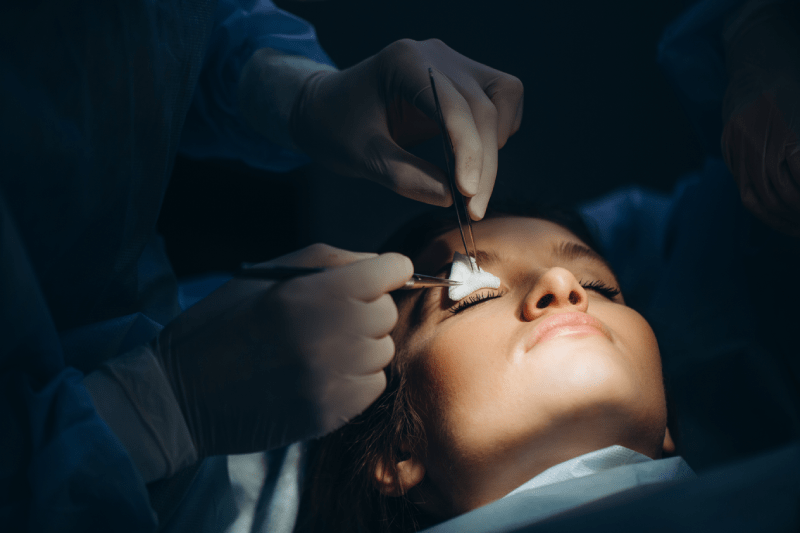
Average Stay Duration for Surgery in Turkey
Since upper eyelid aesthetics is a minimally invasive procedure, the required stay in Turkey is short. The recommended average stay for stitch removal and the surgeon’s final check is 7 to 10 days. This period allows for significant reduction of swelling and bruising, enabling the patient to return to social life. Cure Holiday plans this 7-10 day period by combining the advantages of comfortable accommodation and a recovery holiday.
Fast Appointment and Access to Treatment in Aesthetic Surgery in Turkey
Unlike the months-long waiting times for appointments and surgeries in aesthetic surgery clinics in Europe and North America, Turkey’s biggest advantage is fast access. With Cure Holiday, patients can typically travel to Turkey and undergo surgery within a few weeks after completing the online consultation and pre-operative preparation. This speed allows patients to resolve their aesthetic concerns and functional complaints in a short time.
Advantage of Integrating Treatment with Travel and Holiday Plans
Upper eyelid aesthetics, due to its short recovery time, allows for easy integration of treatment and holiday plans. Patients can spend the first 10 days of the post-operative recovery period resting in hotel comfort or engaging in light cultural excursions. Relieving the stress of the treatment with the experience of discovering a new culture or enjoying the sun significantly contributes to the psychological aspect of recovery.
Flight Safety and Timing After Surgery
Flying after blepharoplasty is generally safe. However, to avoid increasing swelling and protect the incision line, it is usually recommended to travel by plane after the stitches are removed (around 5 to 7 days after surgery). On long flights, frequent movement and drinking plenty of fluids are important for maintaining blood circulation. Your surgeon will confirm your fitness to travel after the final check before your return flight.
Cure Holiday: Your Reliable Health Partner in Turkey
Cure Holiday is your reliable and professional health tourism partner that organizes the entire journey of international patients undergoing Upper Eyelid Aesthetics from start to finish. Our goal is not only to connect you with the best surgeon but also to manage all logistics, accommodation, and communication processes, offering you a stress-free experience. By working with Turkey’s best JCI-accredited hospitals and specialized surgeons, we guarantee quality and safety.
How Does the Cure Holiday Upper Blepharoplasty Treatment Process Start?
The Cure Holiday treatment process begins with your first online contact. Your existing photos and medical history are evaluated by our expert surgeons. A dedicated video consultation with your surgeon is arranged. Upon your arrival in Turkey, you are met with VIP transfers and settled into your comfortable hotel. The pre-operative final checks and the surgical procedure are performed at a JCI-accredited hospital. You are monitored throughout your recovery, your stitches are removed, and you safely return to your country.
Free Online Consultation Opportunity Before Treatment
Cure Holiday organizes free online video consultations to ensure patients are fully informed about their treatment plan and confident in their surgeon before traveling to Turkey. During this consultation, your surgeon evaluates your eyelid condition, determines the most suitable surgical technique (amount of skin and fat removal), and explains the expected results in detail. This transparent pre-consultation is vital for the patient’s mental preparation and gaining full knowledge of the process.
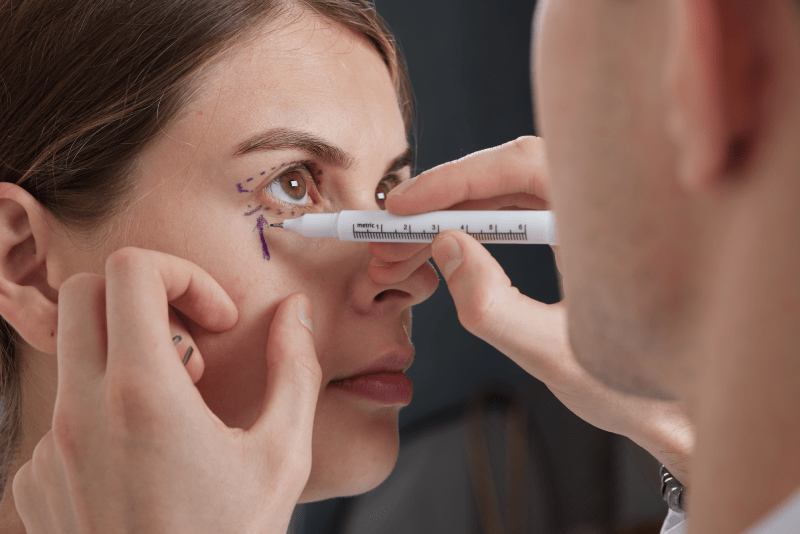
All-Inclusive Packages Offered by Cure Holiday
Cure Holiday’s upper blepharoplasty packages offer both cost transparency and comfort. Our packages typically cover: Surgical operation fees, anesthesia fees, surgeon and hospital fees, VIP airport and clinic transfers, luxury accommodation (5-star hotel or comfortable residence) for the specified duration, necessary medications, and 24/7 personal translator/escort support. This “all-inclusive” approach prevents patients from encountering surprise additional costs.
VIP Transfer and Comfortable Accommodation Advantage
Post-operative comfort is essential for rapid healing. Cure Holiday provides all your transportation, from the airport to the hotel and clinic visits, with private, hygienic, and comfortable VIP vehicles. Accommodation is arranged in high-standard, comfortable facilities close to the clinic, chosen to ensure a peaceful recovery period. This logistical arrangement ensures that the patient feels relaxed and secure even during the bruising and swelling phase.
24/7 Personal Translator and Escort Services
For international patients, the language barrier, lack of information, and feeling of isolation increase post-operative stress. Cure Holiday eliminates this situation. Throughout your treatment, you are assigned a personal escort and medical translator who speaks your native language, is familiar with medical terminology, and is available 24/7. This person provides continuous support in everything from doctor visits to discharge procedures and daily needs, ensuring the patient feels at home.
Cost Transparency and Absence of Hidden Fees
Cost transparency is a core principle highly valued by Cure Holiday. The “all-inclusive” package price offered to you covers all predetermined services completely. The price determined during the pre-operative consultation is the final price you will encounter at the end of the treatment. This guaranteed approach ensures patients feel financially secure, with no unexpected extra charges or cost shocks.
Long-Term Follow-up Support After Returning to Your Country
Cure Holiday continues to maintain contact with you even after your treatment is completed and you return to your country. The detailed healing and follow-up plan prepared by your surgeon is handed over to you. Furthermore, through remote consultations or communication channels, the opportunity to quickly communicate and receive advice from Turkish specialists is provided. This ensures that your recovery process continues safely and without interruption.
Post-Surgery Care and Check-ups with Cure Holiday
Cure Holiday meticulously manages the patient’s care during the critical first 7-10 day recovery period post-surgery. Stitch removal, wound dressings, and swelling management are strictly performed at the clinic by your expert surgeon on scheduled days. Necessary medications and instructions for ice application for bruising and swelling management are provided. This close monitoring is vital for the early detection and rapid intervention of any potential complications.
Contact Now for a Safe and Youthful Expression!
Do not let tired eyes reflect your age and energy. Achieving a young, vibrant, and rested look with upper eyelid aesthetics is now very easy. Embark on this journey with Turkey’s best plastic surgeons and Cure Holiday’s luxury, safe, and economical health tourism packages. Contact Cure Holiday today to create your personalized treatment plan and start your recovery journey immediately. With a single decision, restore the sparkle in your gaze!
